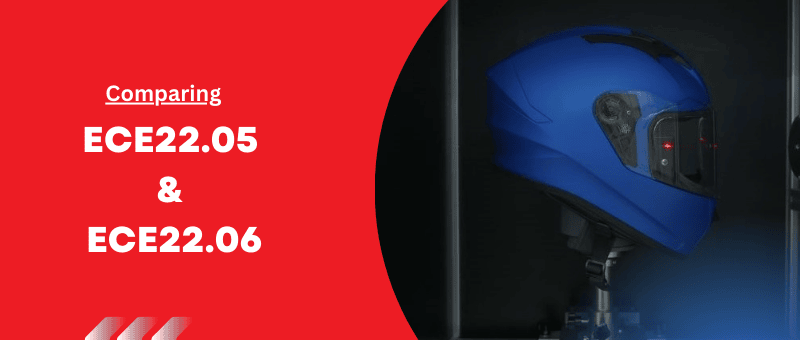Comparing ECE 22.05 and ECE 22.06
For motorcycle riders, a helmet is more than just a fashionable accessory; it’s a crucial safety equipment. The ECE or the Economic Commission for Europe’s 22.05 standard has been the benchmark for helmet safety in Europe for the last 20+ years. The latest addition to this safety standard was implemented at the end of 2023 and is referred to as ECE 22.06. Before we dive deep into the differences between the two safety standards, let us understand what these safety standards are used for. Economic Commission for Europe’s guideline 22 consists of a set of rules and regulations that a helmet must clear before being sold in the market. If the helmets do not meet these standards, it is deemed unfit to be sold in the market where ECE 22.0X is considered an acceptable standard.
With advancements in technology and an improved understanding of crash dynamics, an upgrade was necessitated. That led to ECE 22.06, the successor standard that brings a significant leap forward in helmet safety. In this blog, we will be discussing some of the key differences between the two standards and how they will impact our ride.
Enhanced Impact Testing for a More Realistic Scenario
One of the most significant changes in ECE 22.06 lies in the impact testing procedure. Here’s what’s new:
- More Impact Points: The number of helmet impact zones required to be tested in an laboratory impact testing procedure has increased from 6 impact points in ECE 22.05 to 18 points in ECE 22.06, thereby providing a more comprehensive assessment of a helmet’s ability to absorb impact across its entire surface. Don’t worry! This doesn’t mean that your ECE 22.05 won’t protect you anymore, it will still be good.
- Expanded Velocity Range: Helmets are now required to be tested at a wider range of speeds, including higher and lower velocities including 6 m/s, 7.5 m/s, and 8.2 m/s, reflecting the diverse scenarios riders can encounter on the road.
- Rotational Acceleration Test: This test is not present in ECE 22.05 and is introduced in the new standards. This evaluates a helmet’s effectiveness in mitigating rotational forces on the head during a crash, a significant factor in brain injuries.
- High-Speed Particle Impact: Earlier, visors (or shields as they are refered to in some countries) were exempt from the standards. Now, it is not the case. A high-speed particle test ensures the visor can withstand debris or stones flung up during a ride, offering crucial facial protection.
Rigorous Retention System Evaluation
The new standard also introduces a stricter approach to testing the helmet’s retention system, the mechanism that keeps the helmet securely on your head. Here’s what you can expect:
- Reverse Direction Test: The retention system is now tested in both the forward and reverse directions, simulating the forces exerted during a frontal impact.
- Low and High Energy Impacts: The new standard requires testing at various impact energies, mimicking a wider range of accident severities.
Strengthened Shell and Improved Impact Absorption
ECE 22.06 doesn’t just focus on testing procedures; it also mandates improvements in helmet construction:
- More Specific Impact Areas: As compared to before, Helmets with ECE 22.06 are now tested at a more specific set of impact zones, ensuring crucial areas like the forehead and temples receive adequate protection.
- Increased Rigidity: With ECE 22.05, the maximum deformation limit was 15mm while undergoing rigidity test. With the new reforms, the maximum deformation has been increased to 50mm to enhance structural integrity.
- New Impact Zones: The new standard also introduces additional impact points like the front lateral right, rear lateral left, and front and rear lateral right, ensuring comprehensive coverage.
SMK Helmets: Embracing the Evolution of Helmet Safety
At SMK Helmets, we understand the importance of continuous improvement in rider safety. Here’s how we’re incorporating the new ECE 22.06 standards into our helmets:
- Upgraded Impact Test Machine: Our testing facilities have been equipped with cutting-edge machinery that complies with the new impact testing protocols of ECE 22.06 thus making our helmets – ECE certified.
- Enhanced Retention System Testing: To comply with the rules and bring out the new ECE certified helmets, we’ve invested in upgraded equipment to conduct the more rigorous retention system tests as mandated by the new standard.
- Procurement of High-Speed Particle Test Machine: SMK recognizes the importance of visor protection. We have procured high-speed particle testing machines to ensure our visors are a part of ECE certified helmets
The Takeaway: Choosing a Helmet for Enhanced Protection
The implementation of ECE 22.06 signifies a significant leap in motorcycle helmet safety. The comprehensive impact testing procedures provides a more realistic picture of a helmet’s effectiveness in real-world crashes. The stricter requirements for retention system strength and shell rigidity further bolster the helmet’s ability to protect riders in the event of an accident.
As we end this blog, let’s look up at some of the key differences between the two testing standards.
While both standards ensure a baseline level of safety, ECE 22.06 offers a significant upgrade:
- Limited Impact Testing: While the older standard employed certain impact points, the new standard adds to it and also increases the range of test velocities.
- Rotational Acceleration Test: This test has been added in ECE 22.06
- High-Speed Particle Test: Adding to the visor protection tests of the previous standard, ECE 22.06 increases the rigidity of the tests.
- Stringent Retention System Test: To the already present tests of ECE 22.05, reverse direction test and other impact energies have been inculcated in ECE 22.06 for retention system evaluation.
With the evolving riding conditions and scenarios, along with technological advancements happening at an accelerated pace, helmet safety standards have to keep up. This does not imply that the old standards were not safe, it’s just the new standards have evolved with the times to keep our riders safe
Happy Riding!
#smkisyou

